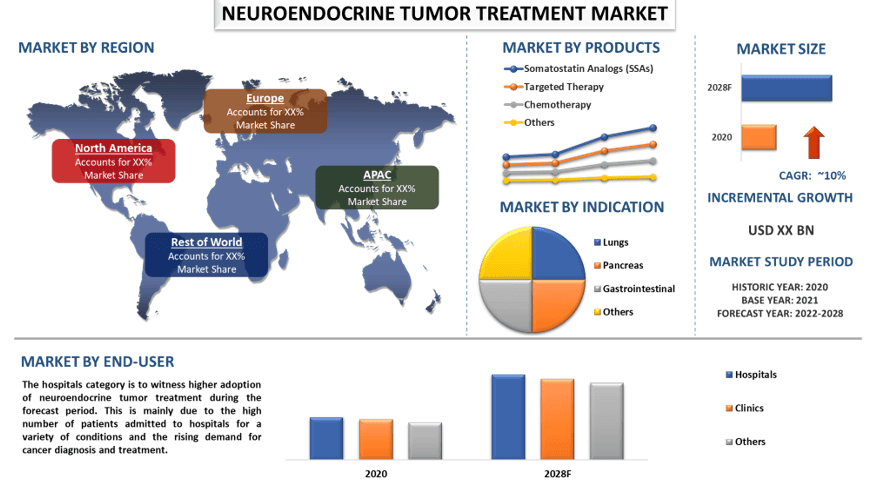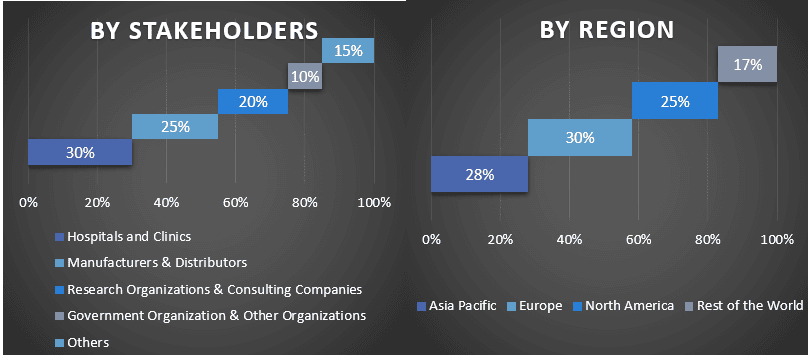- Startseite
- Über uns
- Industrie
- Dienstleistungen
- Lesen
- Kontaktieren Sie uns
Neuroendokrine Tumorbehandlung Markt: Aktuelle Analyse und Prognose (2022-2028)
Fokus auf Produkte (Somatostatin-Analoga (SSAs), zielgerichtete Therapie, Chemotherapie und Sonstige); Indikation (Lunge, Bauchspeicheldrüse, Magen-Darm-Trakt und Sonstige); Endverbraucher (Krankenhäuser, Kliniken und Sonstige); und Region/Land

Es wird erwartet, dass der globale Markt für die Behandlung von neuroendokrinen Tumoren im Prognosezeitraum 2022-2028 mit einer erheblichen Rate von etwa 10 % wachsen wird. Im Laufe des Prognosezeitraums wird erwartet, dass ein Anstieg der Anzahl von Fällen von neuroendokrinen Tumoren (NETs) die Nachfrage nach verschiedenen Behandlungsoptionen beschleunigen wird. Da neue Diagnostika und Therapien entwickelt werden, ist dies ein sich schnell entwickelndes Gebiet. Die Nachfrage nach dem NET-Behandlungsmarkt wird hauptsächlich durch laufende F&E-Bemühungen in Bezug auf Erkennungsmethoden wie Radiofrequenzablation und Ga-markierte Radionukleotidtherapien angetrieben.
So befindet sich beispielsweise der PSMA-Targeted PET Imaging Agent von Progenics Pharmaceuticals, Inc. derzeit in der klinischen Erprobungsphase und wird voraussichtlich bei der Behandlung von Prostatakrebs helfen. Ein weiterer wichtiger Faktor, der die Expansion des NET-Marktes antreibt, sind die beträchtlichen Investitionen in diesem Bereich durch Krebsforschungsorganisationen und Regierungen weltweit.
Pfizer Inc., Novartis AG, Chiasma Inc., Ipsen, Abbvie Inc., Valeant Pharmaceuticals International Inc., Jubilant Life Sciences Ltd., Teva Pharmaceutical Industries Ltd, F. Hoffmann-La Roche Ltd. und Advanced Accelerator Applications. sind einige der wichtigsten Akteure auf dem Markt. Mehrere Fusionen und Übernahmen sowie Partnerschaften wurden von diesen Akteuren durchgeführt, um Kunden mit Hightech- und innovativen Produkten/Technologien zu unterstützen.
Im Bericht dargestellte Erkenntnisse
"Unter den Indikationen wird die gastrointestinale Kategorie im Prognosezeitraum ein robustes CAGR erleben"
Basierend auf dem Typ ist der Markt in Lunge, Bauchspeicheldrüse, Magen-Darm-Trakt und andere unterteilt. Unter diesen wird die gastrointestinale Kategorie im Prognosezeitraum das höchste CAGR aufweisen, da mehr Patienten mit gastrischen neuroendokrinen Wucherungen beobachtet werden, so dass eine zunehmende Bedeutung und das Antreiben dieses Segments zu beobachten ist.
Darüber hinaus wird erwartet, dass der Anteil der Bauchspeicheldrüse in den folgenden Jahren ein kontinuierliches Wachstum aufweisen wird. Es wird erwartet, dass die Expansion des Marktes durch einen Anstieg der F&E-Ausgaben für die Entwicklung neuartiger Therapien für pankreatische NETs unterstützt wird. SUNITINIB von Pfizer Inc. wird in einer klinischen Phase-III-Studie zur Behandlung von NETs in der Bauchspeicheldrüse getestet.
"Unter den Endverbrauchern werden die Krankenhäuser im Jahr 2020 einen bedeutenden Anteil am Markt halten"
Auf der Grundlage des Antriebstyps ist der Markt in Krankenhäuser, Kliniken und andere Kategorien unterteilt. Unter diesen wird die Kategorie Krankenhäuser im Jahr 2020 einen bedeutenden Anteil am Markt halten. Dies ist hauptsächlich darauf zurückzuführen, dass diese Einrichtungen für viele diagnostische Verfahren genutzt werden, eine große Anzahl von Patienten in Krankenhäusern behandelt wird und ausgebildete Fachkräfte zur Verfügung stehen. Es wird erwartet, dass die Expansion des Segments durch die Verfügbarkeit zahlreicher NET-Diagnoseoptionen und entwickelter Technologien weiter gestärkt wird.
"Nordamerika wird einen bedeutenden Anteil am Markt halten"
Für ein besseres Verständnis der Marktdurchsetzung der Herzüberwachungsindustrie wird der Markt anhand seiner weltweiten Präsenz in den Ländern Nordamerika (USA, Kanada, Restliches Nordamerika), Europa (Deutschland, Vereinigtes Königreich, Frankreich, Spanien, Italien, Restliches Europa), Asien-Pazifik (China, Japan, Indien, Australien, Südkorea, Restliches Asien-Pazifik) und dem Rest der Welt analysiert. Die nordamerikanische Region verhalf der Region zu einer dominierenden Position auf dem Markt. Dies ist hauptsächlich auf die gut etablierte Gesundheitsinfrastruktur und die Verfügbarkeit von medizinischem Fachpersonal zurückzuführen. Darüber hinaus treiben die steigenden Fallzahlen von gastrischen neuroendokrinen Tumoren, neuroendokrinen Lungentumoren, neuroendokrinen Pankreastumoren und Karzinoidtumoren in der Region das Wachstum des Marktes voran. Zum Beispiel, cKarzinoidtumoren betreffen zwischen 3.000 und 30.000 Menschen in den Vereinigten Staaten, wie aus den im Jahr 2021 vom National Center for Advancing Translational Sciences Genetic and Rare Diseases Information Center aktualisierten Daten hervorgeht. Diese Tumoren entstehen typischerweise im Magen-Darm-Trakt oder in der Lunge. Es wird erwartet, dass sich der Markt aufgrund der weit verbreiteten Inzidenz von neuroendokrinem Krebs in der Region ausweiten wird.
Gründe für den Kauf dieses Berichts:
- Die Studie umfasst eine Marktdimensionierungs- und Prognoseanalyse, die von authentifizierten wichtigen Branchenexperten validiert wurde.
- Der Bericht bietet einen schnellen Überblick über die Gesamtleistung der Branche auf einen Blick.
- Der Bericht enthält eine eingehende Analyse der wichtigsten Branchenteilnehmer mit einem primären Fokus auf die wichtigsten Finanzdaten des Unternehmens, das Produktportfolio, Expansionsstrategien und die jüngsten Entwicklungen.
- Detaillierte Untersuchung von Treibern, Einschränkungen, wichtigen Trends und Chancen in der Branche.
- Die Studie deckt den Markt umfassend über verschiedene Segmente hinweg ab.
- Tiefgreifende regionale Analyse der Branche.
Anpassungsoptionen:
Der globale Markt für die Behandlung von neuroendokrinen Tumoren kann je nach Bedarf oder einem anderen Marktsegment weiter angepasst werden. Darüber hinaus versteht UMI, dass Sie möglicherweise Ihre eigenen geschäftlichen Anforderungen haben. Zögern Sie daher nicht, sich mit uns in Verbindung zu setzen, um einen Bericht zu erhalten, der vollständig auf Ihre Anforderungen zugeschnitten ist.
Inhaltsverzeichnis
Forschungs-Methodik für die Marktanalyse zur Behandlung von neuroendokrinen Tumoren (2022-2028)
Die Analyse des historischen Marktes, die Schätzung des aktuellen Marktes und die Prognose des zukünftigen Marktes des globalen Marktes für die Behandlung von neuroendokrinen Tumoren waren die drei wichtigsten Schritte, die unternommen wurden, um die Akzeptanz der Behandlung von neuroendokrinen Tumoren in den wichtigsten Regionen weltweit zu erstellen und zu analysieren. Es wurde eine umfassende Sekundärforschung durchgeführt, um die historischen Marktzahlen zu erfassen und die aktuelle Marktgröße zu schätzen. Zweitens wurden zahlreiche Erkenntnisse und Annahmen berücksichtigt, um diese Erkenntnisse zu validieren. Darüber hinaus wurden ausführliche Primärinterviews mit Branchenexperten entlang der Wertschöpfungskette des globalen Marktes für die Behandlung von neuroendokrinen Tumoren geführt. Nach der Annahme und Validierung der Marktzahlen durch Primärinterviews haben wir einen Top-Down/Bottom-Up-Ansatz verwendet, um die vollständige Marktgröße zu prognostizieren. Danach wurden Marktaufschlüsselungs- und Datentriangulationsmethoden angewendet, um die Marktgröße von Segmenten und Untersegmenten der betreffenden Branche zu schätzen und zu analysieren. Die detaillierte Methodik wird im Folgenden erläutert:
Analyse der historischen Marktgröße
Schritt 1: Eingehende Untersuchung von Sekundärquellen:
Es wurde eine detaillierte Sekundärstudie durchgeführt, um die historische Marktgröße des Marktes für die Behandlung von neuroendokrinen Tumoren über unternehmensinterne Quellen wie Jahresberichte und Finanzberichte, Performance-Präsentationen, Pressemitteilungen usw. und externe Quellen wie Fachzeitschriften, Nachrichten und Artikel, Regierungsveröffentlichungen, Wettbewerbsveröffentlichungen, Branchenberichte, Datenbanken von Drittanbietern und andere glaubwürdige Veröffentlichungen zu erhalten.
Schritt 2: Marktsegmentierung:
Nachdem wir die historische Marktgröße des Marktes für die Behandlung von neuroendokrinen Tumoren erhalten hatten, führten wir eine detaillierte Sekundäranalyse durch, um historische Markteinblicke und Anteile für verschiedene Segmente und Untersegmente für wichtige Regionen zu erhalten. Wichtige Segmente, die im Bericht enthalten sind, sind Produkte, Indikation und Endverbraucher. Darüber hinaus wurden Analysen auf Länderebene durchgeführt, um die allgemeine Akzeptanz von Testmodellen in dieser Region zu bewerten.
Schritt 3: Faktorenanalyse:
Nachdem wir die historische Marktgröße verschiedener Segmente und Untersegmente erfasst hatten, führten wir eine detaillierte Faktorenanalyse durch, um die aktuelle Marktgröße des Marktes für die Behandlung von neuroendokrinen Tumoren zu schätzen. Darüber hinaus führten wir eine Faktorenanalyse unter Verwendung von abhängigen und unabhängigen Variablen wie verschiedenen Produkten, Indikationen und Endverbrauchern der Behandlung von neuroendokrinen Tumoren durch. Eine gründliche Analyse wurde für Nachfrage- und Angebotsseitenszenarien unter Berücksichtigung von Top-Partnerschaften, Fusionen und Übernahmen, Geschäftsausweitungen und Produkteinführungen im Sektor der Behandlung von neuroendokrinen Tumoren weltweit durchgeführt.
Aktuelle Schätzung und Prognose der Marktgröße
Aktuelle Marktgrößenbestimmung: Basierend auf den umsetzbaren Erkenntnissen aus den oben genannten 3 Schritten haben wir die aktuelle Marktgröße, die wichtigsten Akteure auf dem globalen Markt für die Behandlung von neuroendokrinen Tumoren und die Marktanteile der Segmente ermittelt. Alle erforderlichen prozentualen Anteile und Marktaufschlüsselungen wurden mithilfe des oben genannten Sekundäransatzes ermittelt und durch Primärinterviews verifiziert.
Schätzung und Prognose: Für die Marktschätzung und -prognose wurden verschiedenen Faktoren, einschließlich Triebkräften und Trends, Beschränkungen und Möglichkeiten für die Beteiligten, Gewichte zugewiesen. Nach der Analyse dieser Faktoren wurden relevante Prognosetechniken, d. h. der Top-Down/Bottom-Up-Ansatz, angewendet, um die Marktprognose für 2028 für verschiedene Segmente und Untersegmente in den wichtigsten Märkten weltweit zu erstellen. Die Forschungsmethodik zur Schätzung der Marktgröße umfasst:
- Die Marktgröße der Branche in Bezug auf Umsatz (USD) und die Akzeptanzrate des Marktes für die Behandlung von neuroendokrinen Tumoren in den wichtigsten Märkten im Inland
- Alle prozentualen Anteile, Aufteilungen und Aufschlüsselungen von Marktsegmenten und Untersegmenten
- Wichtige Akteure auf dem globalen Markt für die Behandlung von neuroendokrinen Tumoren in Bezug auf die angebotenen Produkte. Auch die Wachstumsstrategien, die diese Akteure anwenden, um in dem schnell wachsenden Markt zu konkurrieren
Validierung von Marktgröße und -anteil
Primärforschung: Es wurden ausführliche Interviews mit den Key Opinion Leaders (KOLs) geführt, darunter Führungskräfte der obersten Ebene (CXO/VPs, Vertriebsleiter, Marketingleiter, Betriebsleiter, Regionalleiter, Länderleiter usw.) in den wichtigsten Regionen. Die Ergebnisse der Primärforschung wurden dann zusammengefasst und eine statistische Analyse durchgeführt, um die aufgestellte Hypothese zu beweisen. Die Erkenntnisse aus der Primärforschung wurden mit den Ergebnissen der Sekundärforschung zusammengeführt, wodurch Informationen in umsetzbare Erkenntnisse umgewandelt wurden.
Aufteilung der primären Teilnehmer in verschiedenen Regionen

Marktgestaltung
Die Datentriangulationstechnik wurde angewendet, um die Gesamtmarktschätzung abzuschließen und präzise statistische Zahlen für jedes Segment und Untersegment des globalen Marktes für die Behandlung von neuroendokrinen Tumoren zu erhalten. Die Daten wurden in mehrere Segmente und Untersegmente aufgeteilt, nachdem verschiedene Parameter und Trends in den Bereichen Produkte, Indikation und Endverbraucher auf dem globalen Markt für die Behandlung von neuroendokrinen Tumoren untersucht worden waren.
Das Hauptziel der globalen Marktstudie zur Behandlung von neuroendokrinen Tumoren
Die aktuellen und zukünftigen Markttrends des globalen Marktes für die Behandlung von neuroendokrinen Tumoren wurden in der Studie genau bestimmt. Investoren können strategische Einblicke gewinnen, um ihre Entscheidungen für Investitionen auf der Grundlage der in der Studie durchgeführten qualitativen und quantitativen Analyse zu treffen. Aktuelle und zukünftige Markttrends bestimmten die Gesamtattraktivität des Marktes auf regionaler Ebene und boten den Industrieteilnehmern eine Plattform, um den unerschlossenen Markt zu nutzen und von einem First-Mover-Vorteil zu profitieren. Weitere quantitative Ziele der Studien sind:
- Analyse der aktuellen und prognostizierten Marktgröße des Marktes für die Behandlung von neuroendokrinen Tumoren in Bezug auf den Wert (USD). Analysieren Sie auch die aktuelle und prognostizierte Marktgröße verschiedener Segmente und Untersegmente
- Die Segmente in der Studie umfassen die Bereiche Produkte, Indikation und Endverbraucher.
- Definition und Analyse des regulatorischen Rahmens für die Industrie zur Behandlung von neuroendokrinen Tumoren.
- Analyse der Wertschöpfungskette unter Einbeziehung verschiedener Vermittler sowie Analyse des Kunden- und Wettbewerbsverhaltens der Branche.
- Analyse der aktuellen und prognostizierten Marktgröße des Marktes für die Behandlung von neuroendokrinen Tumoren für die wichtigsten Regionen.
- Zu den wichtigsten Ländern der in dem Bericht untersuchten Regionen gehören der asiatisch-pazifische Raum, Europa, Nordamerika und der Rest der Welt.
- Unternehmensprofile des Marktes für die Behandlung von neuroendokrinen Tumoren und die Wachstumsstrategien, die von den Marktteilnehmern angewendet werden, um sich in dem schnell wachsenden Markt zu behaupten
- Eingehende Analyse der Branche auf regionaler Ebene
Verwandt Berichte
Kunden, die diesen Artikel gekauft haben, kauften auch










